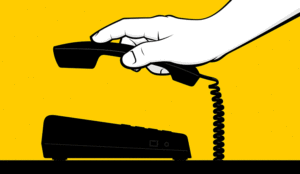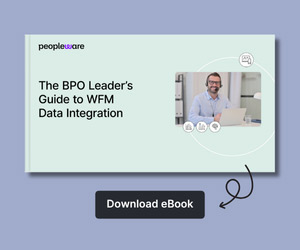Filipa Silva at Talkdesk explains what call centre abandonment rate is, and why it matters.
Customers call contact centres to have an issue resolved. Unfortunately, that’s not always what happens. Sometimes those calls are abandoned.
In this post, we’ll look at how to calculate abandonment rate, give you benchmarking metrics for specific industries and walk through how your team can improve your call abandonment rate to service customers better.
Call abandonment rate is directly connected with average wait time (AWT). The longer customers have to wait before talking to an agent, the higher the call abandonment rate, as people get tired of waiting for support and hang up before talking to an agent.
What Is Call Centre Abandonment Rate?
Call centre abandonment rate is a call centre metric that records the percentage of calls terminated by callers after being placed in a queue (after going through an IVR and before ringing at an agent or ring group).
Call abandonment rate gives insights into the number of calls that ended before an agent could answer the caller’s question.
Call abandonment happens for a variety of reasons, including a mistake on the customer’s end or customers growing impatient because it’s taking too long to reach an agent.
Benchmarking and diagnosing your average call abandonment rate can have a huge impact on your overall customer experience (CX).
What Is an Abandoned Call?
An abandoned call is a call that disconnects (or is terminated by the caller) before the caller was routed to an agent. Inbound callers typically abandon in the IVR or waiting queue.
In today’s environment of rising customer expectations around real-time, personalized service, it’s imperative that you are successfully connecting with as many inbound customers as possible.
Short abandons, however – or calls that are disconnected before a predetermined number of seconds – should be filtered out so as not to skew the call centre call abandonment rate and impair sound management decisions.
Abandoned calls should not be confused with:
- Missed calls. Calls that are deliberately disconnected by the call centre because an agent failed to pick up the call before reaching the maximum wait time limit set by the ACD system.
- Dropped calls. Calls that unintentionally disconnect, usually due to a technical failure. Additionally, it is common for contact centres to define a time threshold below which calls are considered dropped.
- Lost calls. Abandoned calls, missed calls, and dropped calls are all categorized as lost calls.
- Short calls. If the caller hangs up seconds after the advisor picks up, it’s considered a short call. Short calls are not considered abandoned.
How to Calculate Average Call Abandonment Rate.
To measure average call abandonment rate in your contact centre, divide the number of abandoned calls or interactions by the total number of inbound calls or interactions.
| Abandonment Rate = | # Abandoned Calls in Queue |
| Total # Inbound Calls – # Abandoned Calls Not in Queue |
At Talkdesk, we measure the average call abandonment rate by first configuring an abandoned short calls threshold to filter out short call data. It’s a best practice to exclude calls that were abandoned in the first five seconds.
We used that threshold when we collected data for the 2021 Talkdesk global contact centre KPI benchmarking report.
In 2020, we saw an average abandonment rate of 5.91% for all Talkdesk users.
Why Do Call Abandonment Rates Matter?
Measuring call abandonment rate is only half the battle. You need to understand what this metric means to your business and how to respond, especially if the result falls outside of your predefined target range.
High abandonment rates could indicate that:
- Routing setup is incorrect or is driving up AWT.
- Staffing is inadequate, causing callers to queue for unacceptable amounts of time.
- Processes are complex, or systems are scattered.
Low abandonment rates could indicate that:
- Agents handle calls quickly.
- Routing is optimized.
- The team is properly staffed or even overstaffed.
5 Ways to Optimize Average Call Abandonment Rate.
1. Employ Workforce Management Tools and Improve Call Peaks Forecasting.
Call abandonment rate is directly and inversely correlated with the number of available agents in a given time. Hence, assessing contact centre historical data can help access past patterns of call volumes.
Because average call abandonment time changes throughout the day – and even daily – segmenting contacts by hour of day or day of the week is a best practice to support call peaks forecasting and improve scheduling.
However, being more efficient in distributing agents is just the first step – you should also focus on assigning the best available agent. Workforce Management solutions can assist teams by automatically allocating the most skilled, available agent for a faster resolution.
2. Automate Repetitive Tasks So Agents Can Focus on Delighting Customers.
When agents are not available, that means they are either answering calls or handling after-call work. Consider AI-powered tools to handle simple and often repetitive tasks, freeing agents to focus on the interactions that matter.
Automating AI-powered customer information transcriptions and after-call work reduces average handle time (AHT).
Moreover, using agent assistance technology enables more accurate and timely resolutions, giving agents relevant information while handling calls and reducing new hires’ ramp-up times.
3. Deflect Calls With an Omnichannel Strategy.
Sudden spikes in customer service demand don’t have to result in a high pressure environment for contact centres.
Instead, analyse what other contact channels you can add to the customer journey to help face call peaks. Not only does it help to deflect calls, but also drives the benefits of digital channels 24/7 and on-demand.
Additionally, AI-powered conversational assistants, or “virtual agents“, can quickly deliver the answers and outcomes over voice or text-enabled channels while shifting to agents for more complex issues, sharing crucial contextual information that make conversations more efficient.
An omnichannel strategy provides contact centres with a cost-effective and scalable self-service solution that can help reduce call abandonment rates.
4. Implement a Call-Back Option.
Call-backs don’t necessarily impact call abandonment rate, but they can reduce abandonment consequences.
If you think about it, abandoned calls are either a lost sale opportunity or failure to deliver first class customer service, both impacting the overall customer experience (CX) and driving down customer satisfaction (CSAT) scores.
One easy way to reduce call abandonment rate is by offering a call-back request. This approach guarantees that you maintain the contact opportunity and is a cost-effective option for peaks in customer service demand.
5. Use In-Queue Time to Deliver Important Information.
Rather than using repetitive music or standard voice messages like “Please wait until an agent is ready to assist you”, use the time customers wait in the queue to deliver relevant messages.
For example, convey that other channels are available and can be used as an alternative, inform about the estimated waiting time, or gather relevant information for the agent.
Conclusion.
Call abandonment rate is one of the most important KPIs for a successful contact centre.
For companies that provide customer support through voice, call abandonment rates should be consistently monitored and kept as low as possible. High call abandonment rates usually happen when hold times are too long and result in poor customer service.
Keeping call abandonment rates as low as possible means that customers receive the experience they called for, be it service, sales, or technical support.
The right contact centre platform provider allows any business, regardless of type or size, to collect insights for this KPI and maintain a call abandonment rate above industry average, increasing CSAT.
This blog post has been re-published by kind permission of Talkdesk – View the Original Article
For more information about Talkdesk - visit the Talkdesk Website
Call Centre Helper is not responsible for the content of these guest blog posts. The opinions expressed in this article are those of the author, and do not necessarily reflect those of Call Centre Helper.
Author: Talkdesk
Published On: 30th Jul 2021 - Last modified: 3rd Aug 2021
Read more about - Guest Blogs, Talkdesk






 Talkdesk is a global customer experience leader for customer-obsessed companies. Our contact center solution provides a better way for businesses and customers to engage with one another.
Talkdesk is a global customer experience leader for customer-obsessed companies. Our contact center solution provides a better way for businesses and customers to engage with one another. 












